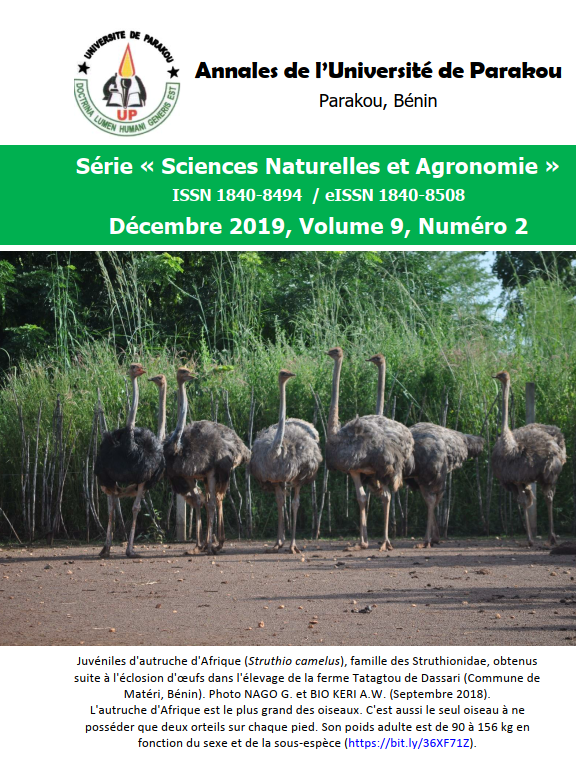Procédé de Production, caractéristiques microbiologique, physicochimique et sensorielle du chakpalo, bière traditionnelle de maïs en Afrique de l’Ouest
DOI :
https://doi.org/10.56109/aup-sna.v9i2.55Mots-clés :
Chakpalo, maïs, consommation, pasteurisation, fermentation, qualitéRésumé
Le chakpalo est une bière traditionnelle du Bénin à base des céréales de sorgho et/ou du maïs. L’objectif de cette étude est d’identifier le système de production, de caractériser le chakpalo du point de vue physico-chimique, microbiologique et sensorielle et de stabiliser le chakpalo à base de maïs. Une enquête a été réalisée dans la zone originelle de production (Dassa Zoumé) sur la production et la commercialisation du chakpalo à base de maïs. Des échantillons de chakpalo produits ont été soumis aux analyses physicochimique, microbiologique et sensorielle. Les résultats ont montré que la production de chakpalo est une activité exclusivement féminine. Quatre types de chakpalo ont été identifiés en relation avec la matière première utilisée pour la production : chakpalo d’un mélange maïs/sorgho, chakpalo de sorgho, chakpalo de maïs et chakpalo du riz. Selon les productrices, un bon chakpalo est de couleur brunâtre, peu acide et légèrement alcoolisé. Au cours du processus de fermentation, la teneur en protéines et en extraits secs solubles ont significativement (p ˂ 0,05) diminué, tandis que la charge en bactéries lactiques et levures ainsi que l’acidité titrable ont significativement (p ˂ 0,05) augmenté. Le chakpalo à base de maïs obtenu est un produit acide ayant un pH de 4,11, une acidité titrable de 0,09 g/100g (d’acide lactique). Il a une teneur en extrait sec soluble de 9,40°brix et taux d’alcool de 3,36%. Après pasteurisation, le chakpalo à base de maïs a un pH de 4,0, un extrait sec soluble de 9,73 °brix significativement (p ˂ 0,05) différentes de celles du chakpalo non pasteurisé. La flore microbienne dominante est constituée de bactéries lactiques et de levures et moisissures. Le test de consommation a montré que la pasteurisation du chakpalo a une influence sur ses attributs sensoriels qui sont bien distincts selon les différents groupes de consommateurs.
Téléchargements
Métriques
Références
AACC. 1984. Approved methods of the American Association of Cereals Chemists. 8th ed. St Paul. MN. USA.
AOAC. 1995. Official Methods of Analysis of the Association of Official Analytical Chemists. Washington: AOAC.
Abdalla, A. A., Eltinay, A. H, Mahamed, B. E. and Adalla, A. H.. 1998. Effect of traditional processes on phytate and mineral content of pearl millet. Food Chemistry, 63:79 – 87 DOI: https://doi.org/10.1016/S0308-8146(97)00194-5
Aka, S., Djeni, N. D. T., N’Guessan, K. F., Yao, K. C., & Dje, K. M. 2008.Variabilité des propriétés physico-chimiques et dénombrement de la flore fermentaire du tchapalo, une bière traditionnelle de sorgho en Côte d’Ivoire. Afrique Science. 4(2): 274 - 286. DOI: https://doi.org/10.4314/afsci.v4i2.61688
Akinrele, I. A. 1970. Fermentation studies on maize during preparation of a traditional African Starch cake food. Journal of the Science of Food and Agriculture. 21: 619- 625. DOI: https://doi.org/10.1002/jsfa.2740211205
Akissoe H.N, Sacca C, Declemy A-L, Bechoff A, Anihouvi V, Dalode G, Pallet D, Fliedel G, Mestres C, Hounhouigan D.J, Tomlins K.I. 2014. Cross-Cultural Acceptance Of A Traditional Yoghurt-Like Product Made From Fermented Cereal. Journal of the Science of Food and Agriculture. 95(9):1876–84. DOI: https://doi.org/10.1002/jsfa.6892
Ballogou, V. Y., Dossou, J. C. A. de Souza, 2011. Controlled Drying Effect on the Quality of Sorghum Malts Used for the Chakpalo Production in Benin. Food. Nutri. Sci. 2: 156-161. DOI: https://doi.org/10.4236/fns.2011.22022
Chamunorwa, A.T., Feresu, S.B., Mutukumira, A.N. 2002. Identification of lactic acid bacteria isolated from opaque beer (Chibuku) for potential use as a starter culture. The Journal of Food Technology in Africa. 7, 93-97. DOI: https://doi.org/10.4314/jfta.v7i3.19239
Chevassus-Agnes, S., Favier ,J.C., Joseph, A.. 1979. Traditional technology and nutritive value of Cameroon sorghum beers. Cah. Onarest. ; 83- 112.
Desobgo, Z.S.C., Naponni, F. Y., Nso, J. E. 2013. Caractérisation des moûts et bières du sorgho Safrari houblonnés avec Vernonia amygdalina et Nauclea diderrichii. International Journal of Innovation and Applied Studies. 2 : 83-91.
Djè M.K, N’Guessan K.F, Djeni T.N.D, Dadié T.A. 2008. Biochemical Changes during Alcoholic Fermentation in the Production of “Tchapalo”, a Traditional Sorghum Beer. International Journal of Food Engineering. 4(7):1-15. DOI: https://doi.org/10.2202/1556-3758.1408
Dossou J, Ballogou V.Y, Amoussou Fagla B, Akissoé N, Daïnou O, de Souza C. 2014. Improving of traditional sorghum (Sorghum bicolor) malting process for chakpalo production in Benin. Bulletin de la Recherche Agronomique du Bénin (BRAB). 76:30-40.
Dossou J, Ballogou VY, Dabadé DS, Dakpo M. 2015. Analyse économique de la production artisanale du chakpalo au Bénin : aspects sociaux et facteurs déterminants de la rentabilité financière de l’activité. Journal of Applied Biosciences. 87:8065- 75. DOI: https://doi.org/10.4314/jab.v87i1.7
Dossou, J., V. Ballogou, C. de Souza. 2011. Étude comparative de la dynamique microbienne et de la qualité du chakpalo fermenté à levure commerciale (Saccharomyces cerevisiae) et au ferment traditionnel et stabilisé par pasteurisation; J. Rech. Sci. Univ. Lomé, Série A, 13(1): 39-51.
Glover RLK, Abaidoo RC, Jakobsen M, Jespersen L. 2005. Biodiversity of Saccharomyces cerevisiae isolated from a survey of pito production sites in various parts of Ghana. Systematic and Applied Microbiology; 28:755-61. DOI: https://doi.org/10.1016/j.syapm.2005.05.003
Hongbété F, Kindossi JM. 2017. Diversity and Traditional Consumption of Edible Insects in North Benin. Journal of Scientific Research and Reports, 14(1):1- 11. DOI: https://doi.org/10.9734/JSRR/2017/32542
Hongbété F, Kindossi JM, Hounhouigan JD, Nago MC. 2018. Production et qualité nutritionnelle des épis de maïs frais bouillis consommés au Bénin. Int J Biol Chem Sci. 11(5):2378. DOI: https://doi.org/10.4314/ijbcs.v11i5.34
Hongbété F, Tidjani A-K, Kindossi JM. 2017. Traditional Production Technology, Consumption And Quality Attributes Of Toubani: A Ready-To-Eat Legume Food From West Africa. African Journal of Biotechnology, 16(19): 1123-1130. DOI: https://doi.org/10.5897/AJB2017.15913
Hounhouigan, D. J., Nout, M. J. R., Nago, C. M., Houben, J. H., and Rombouts F. M. 1993. characterization and frequency distribution of species of lactics bacteria involved in the processing of mawè, a fermented maize dough from Benin. International Journal of Food Microbiology.; 18: 279 – 287 DOI: https://doi.org/10.1016/0168-1605(93)90151-6
INRAB/MAEP. 2010. Répertoire des variétés de maïs vulgarisées au Bénin, document technique d’information et de vulgarisation, 3 décembre 2010, Bénin;11 p
ISO-4833. 2003. Microbiology of food and animal feeding stuffs – Horizontal method for the enumeration of microorganisms – Colony count technique at 30°C (ISO 4833). In: ISO-Microbiology, editor. 3rd ed.; p1-9.
ISO-7954. 1988. General guidance for enumeration of yeast and moulds- colony count technique at 25°C (ISO 7954). In: ISO Microbiology, editor.; pp. 1-4.
ISO-15214. 1998. Microbiology of food and animal feeding stuffs – Horizontal method for the enumeration of mesophilic lactic acid bacteria– Colony-count technique at 30 °C In: ISO-Microbiology, editor. first ed.; pp1-7.
ISO-21528. 2004. Microbiology of food and animal feeding stuffs – Horizontal methods for the detection and enumeration of Enterobacteriaceae – Part 2:Colony-count method (ISO 21528-2). In: ISO-Microbiology, editor. 1st ed.; pp. 1-10.
Iwuoha C. I. and O. S. Eke, 1996. Nigerian indigenous fermented foods, their traditional process operation, inherent problems, improvements and current status. Food Research International. 29(5-6): 527-540 DOI: https://doi.org/10.1016/0963-9969(95)00045-3
Kayodé APP, Hounhouigan DJ, Nout MJR, Niehof A,. 2007. Household production of sorghum beer in Benin: Technological and socio-economical aspects. International Journal of Consumer Studies. 31: 258-264. DOI: https://doi.org/10.1111/j.1470-6431.2006.00546.x
Kutyauripo, J., Parawira, W., Tinofa, S., Kudita, I., Ndengu, C.. 2009. Investigation of shelf-life extension of sorghum beer (Chibuku) by removing the second conversion of malt. International Journal of Food Microbiology.; 129, 271-276. DOI: https://doi.org/10.1016/j.ijfoodmicro.2008.12.008
Louembe, D., Brauman, A., Tchicaya, F. et Kobawiba, S. C. 1996. Etude microbiologique et biochimique de la bouillie de maïs, "Poto-Poto". Microbiologie. Aliments – Nutrition. 14 : 245 - 253.
Lyumugabe, F., Bajyana, S.E, Wathel, J. P., Thonar, P.. 2013. Volatile compounds of the traditional sorghum beers “ikigage” brewed with Vernonia amygdalina “umubirizi” Cerevisia.; 37: 89-96. DOI: https://doi.org/10.1016/j.cervis.2012.12.001
Maoura, N., Mbaiguinam, M., Nguyen, H.V., Gaillardin, C., Pourquie, J. 2005. Identification and typing of the yeast strains isolated from bili bili, a traditional sorghum beer of Chad. African Journal of Biotechnology. 4: 646-656. DOI: https://doi.org/10.5897/AJB2005.000-3117
Mbajiuka, C., Omeh, Y., Ezeja, M. 2010. Fermentation of sorghum using yeast (Saccharomyces cerevisiae) as a starter culture for burukutu production. Continental Journal Biological Sciences 3: 63-74.
Mounir M., Belgrire M., Lahnaoui S., Hamouda A., Thonart P., Delvigne, F. Ismaili Alaoui M. (2016). Maîtrise de la fermentation alcoolique sous stress éthanolique, thermique et osmotique de la souche Saccharomyces cerevisiae YSDN1 en vue de la préparation du vinaigre de fruits. Rev. Mar. Sci. Agron. Vét. 4 (2):86-95
N’Guessan F.K, Coulibaly H.W, Alloue-Boraud M.W.A, Cot M, Djè K.M. 2016. Production of freeze-dried yeast culture for the brewing of traditional sorghum beer, tchapalo. Food Science & Nutrition.; 4 (1):34-41. DOI: https://doi.org/10.1002/fsn3.256
N’guessan, K. F., Brou, K., Jacques, N. m., Casaregola, S., & Dje, K. M. 2011. Identification of yeasts during alcoholic fermentation of tchapalo, a traditional sorghum beer from Côte d’Ivoire. Antonie van Leeuwenhoek,; 99 : 855-864. DOI: https://doi.org/10.1007/s10482-011-9560-7
Nago C.M. 1989. Technologies traditionnelles et alimentation au Bénin : aspects techniques, biochimiques et nutritionnelle. Cotonou, Bénin, Université Nationale du Bénin, 222 p.
Nanadoum Maoura, Mbaiguinam, M., Gaillardin, C. & Pourquie, J. 2006. Suivi technologique, analytique et microbiologique de la ‘’bili bili’’, bière traditionnelle tchadienne. Afrique Science.; 2 : 69-82. DOI: https://doi.org/10.4314/afsci.v2i1.61135
Nout, M.J.R. 1980. Microbiological aspects of the traditional busaa, a Kenyan opaque beer. Chem. Mikrobiol. Technol. Lebensm.; 6:137–142.
Orji, M.U., Mbata, T.I., Aniche, G.N., Ahonkhai, I. 2003. The use of starter cultures to produce ‘Pito’, a Nigerian fermented alcoholic beverage. World Journal Microbiology and Biotechnology.; 19: 733-736. DOI: https://doi.org/10.1023/A:1025172506965
Osseyi, T.E., Karou, S.., Ketevi, A., Lamboni, R. 2011. Stabilization of the Traditional Sorghum Beer, “Tchoukoutou” using Rustic Wine-Making Method. Advance Journal of Food Science and Technology. 3: 254-258.
Sawadogo-Lingani H., Lei V., Diawara B., Nielsen D.S., Møller P.L., Traoré A.S., Jakobsen M. 2007. The biodiversity of predominant lactic acid bacteria in dolo and pito wort for the production of sorghum beer. J. Appl. Microbiol. 103: 765-777. DOI: https://doi.org/10.1111/j.1365-2672.2007.03306.x
Steinkraus KH.. 2002 Fermentations in World Food Processing. Comprehensive reviews in food science and food safety. 1(1):23-32. DOI: https://doi.org/10.1111/j.1541-4337.2002.tb00004.x
Traore, T., Mouquet, C., Icard-Verniere, C., Traore, A.S., Treche, S. 2004. Changes in nutrient composition, phytate and cyanide contents and a-amylase activity during cereal malting in small production units in Ouagadougou (Burkina Faso). Food Chemistry. 88:105–114. DOI: https://doi.org/10.1016/j.foodchem.2004.01.032
Viéira-Dalodé A. G., 2008. Etude de la fermentation de la farine de sorgho pour la production du gowé au Bénin : Aspect physicochimiques et microbiologiques. Doctorat de l’université d’Abomey-Calavi. ; 70 p
Yao A.A, Egounlety M, Kouame L.P, Thonart P., 2009. Les bactéries lactiques dans les aliments ou boissons amylacés et fermentés de l’Afrique de l’Ouest : leur utilisation actuelle. Ann. Méd. Vét.; 153:54-65.














